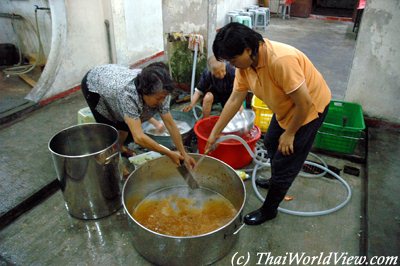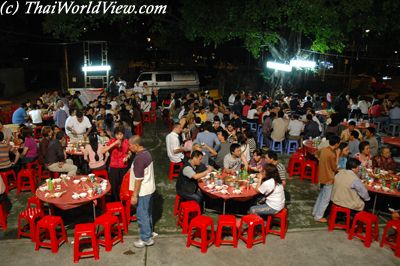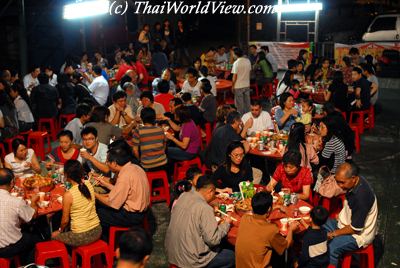

Poon Choi, also known as Big Bowl Feast, is often served during religious rituals, festivals, special occasions and wedding banquets in open area of villages.

|
Basin feast can be hold in village clan's hall but also on village playground.
|
| Village playground |
|---|
Poon Choi is popular among villagers in the New Territories.
|
Guests arrive at late evening. Banquet starts at 6 PM. Once 12 people are sit,
a basin dish is given to them.
|

|
| Village playground |
|---|
This custom of eating food communally originated about 600 years ago.

|
Poon Choi, also known as basin feast, is a traditional type of Chinese food
served in wooden basins instead of the porcelain or metal kind.
|
| Preparing food |
|---|
Poon Choi is special in the way that it is composed of many layers of different ingredients. It is also eaten layer by layer instead of "stirring everything up".
|
Each ingredient is prepared separately by a cook. Then a special team gather all
ingredients in one bowl.
|

|
| Preparing food |
|---|
This culinary custom is also called "Sihk Puhn". It means litteraly "eat basin".

|
This traditional Basin Cuisine or "poon choi" is quite oily but delicious. Poon Choi includes
ingredients such as pork, beef, lamb, chicken, duck, abalone, ginseng, shark fin, fish maw, prawn,
crab, dried mushroom, fishballs, squid, dried eel, dried shrimp, pigskin, beancurd and Chinese radish.
|
| Preparing food |
|---|
|
All villagers are taking part in the Basin Cuisine preparation. It is
an happy atmosphere with talks and laughs.
|

|
| Preparing food |
|---|
Women may help prepare the raw material but males shall do the actual cooking.

|
A Basin Dish consists of 9 courses, prepared with a big wok heated with firewood.
Through stir frying, deep frying, boiling, braising and stewing, courses are
placed in a basin. The course on the top is chicken and duck, implying that birds return
to the nests.
|
| Preparing food |
|---|
Sometimes there are up to 15 courses served.
|
Some ladies are helping to do the dish and big wok washing up.
|

|
| Washing up |
|---|
Meat was a luxury prior to the mid-1950s. So those banquets had a huge contrast to the daily meals served in most village homes. Some banquets are still popular as they also serve to legitimize a social transition such as the transfer of a bride from one family to another.

|
Poon Choi is often served during religious rituals such as
"Tai Ping Ching Chiu" festivals. A few hundreds people
can participate to such huge meals.
Other occasions can be wedding banquets where up to 400 guests
can be invited.
|
| Poon Choi |
|---|
The total amount of food is so much that each table can hardly finish even half of the bowl. Guests can bring the remaining food home.
|
Cooks are resting and enjoying food also. Nobody is left
in the kitchen. A few "poon choi" bowls are still waiting to be
eaten.
|

|
| Poon Choi |
|---|
Poon Choi is associated to events that affect the entire community. It is a symbol of village cohesion, i.e all who eat from the common pot are equals.

|
All guests are enjoying traditional "poon choi" or big bowl feast.
|
| Poon Choi |
|---|
Poon Choi has the symbolic effect of obliterating class and status differences.
|
One cook has prepared secretly a delicious steamed fish. Not
everybody is enjoying "poon choi" food!
|

|
| Steamed fish |
|---|
Click to see more pictures |

|

|

|
| Home > Culture > Traditional festivals > Poon Choi |

|